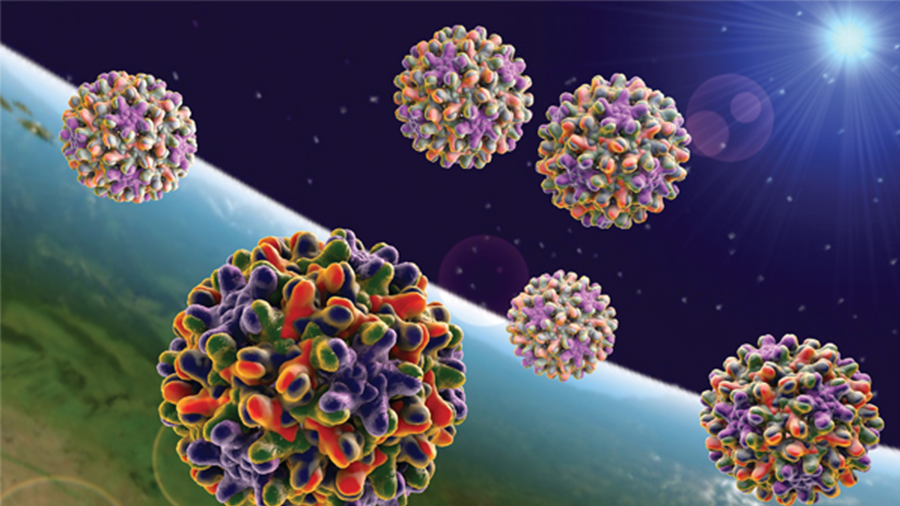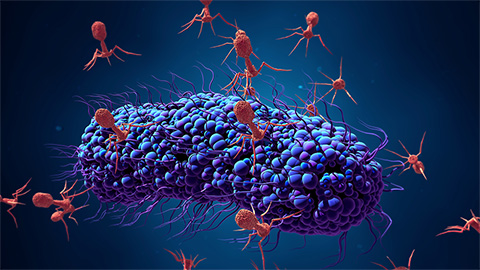World Hepatitis Day
The ASBMB participated in World Hepatitis Day on July 28 by sharing research about the mechanisms and effects of viral hepatitis. World Hepatitis Day is one of the World Health Organization’s eight official global public health campaigns. While advocate groups marked their observances on various dates throughout the years, the WHO picked July 28 in 2010 because the date coincides with the birthday of the late Nobel laureate Baruch Samuel Blumberg, a researcher at the National Institutes of Health who made significant contributions to the study and prevention of hepatitis B.
 A good place for us to start
A good place for us to start
In 2010, the Journal of Biological Chemistry unveiled a thematic series of reviews that showcases advances in understanding the hepatitis C virus. Associate Editor Charles Samuel, who organized the series, notes that two of the authors later shared the Lasker prize for their hepatitis C work. Read the reviews.
Using the prism of proteomics
“(P)roteomics is well positioned to continue to make significant contributions to the field of infectious disease research,” according to Ileana Cristea of Princeton University, who organized a special issue of the journal Molecular & Cellular Proteomics on infectious disease. Read the special issue.The effects of alcohol plus hepatitis B
Studies have shown that damage to the liver affects how the organ creates and clears cholesterol. Studies also have shown that hepatitis B alone and alcohol alone affect cholesterol homeostasis. With those results in mind, a research team in China recently set out to learn more about the combined effects of hepatitis B and alcohol consumption on cholesterol deposition in the liver. They reported their findings in the Journal of Lipid Research. Read their work.
Hepatitis C and insulin resistance
A French research team exploring the molecular basis by which hepatitis C virus induces diabetes reported recently in the Journal of Biological Chemistry that a canonical signaling pathway is disrupted in the liver of infected mice, impairing glucose uptake and leading to insulin resistance. Read the study.
Examining the cancer connection
Infection with hepatitis C is a major risk factor for liver cancer. Learn about how viral proteomics informs what we know about oncogenesis in this review article in the journal Molecular & Cellular Proteomics.
“A gatekeeper in the pathogenesis of viral hepatitis”
Researchers at the Cleveland Clinic discovered that the core protein of hepatitis C virus depends on the lipid droplet scaffold protein perilipin 3 to form a viral lipid envelope and trigger fatty liver disease. Read their study in the Journal of Lipid Research.
The role of exosomes in hepatitis B replication
Hepatocytes infected with hepatitis B virus shed exosomes containing viral proteins and RNA. Researchers investigating the content of these exosomes found that they also have higher than usual proteasome content, which may muffle the immune response during infection. Read the study in the journal Molecular & Cellular Proteomics.
Why grazoprevir is more potent than simeprevir
A paper published in the Journal of Biological Chemistry last year (authored by researchers at the pharmaceutical giant Merck) explored the structural basis for the different potency of two hepatitis C virus protease inhibitors against resistant mutants. Read the study.
Stopping stealthy hepatitis B
The hepatitis B virus can evade normal immune systems. However, a research team in Japan recently reported in the Journal of Biological Chemistry that there is another way HBV can be cleared -- by using a known cellular pathway for RNA degradation. Read the study.
Protein interactions of the Flaviviridae family
A review in the journal Molecular & Cellular Proteomics on hepatitis C viruses and others in its family surveys the viral life cycle and how proteomics studies have contributed to our knowledge of protein dynamics in hepatitis infection. Read the review.
Hepatitis C’s protein interaction network
German researchers used fluorescent labeling, flow cytometry and FRET to establish the first protein-protein interaction network in hepatitis C virus proteins. They reported their results in the journal Molecular & Cellular Proteomics. Read the study.
Hepatitis C and cancer pathway mediators
A study published last year in the Journal of Biological Chemistry explored the basis for HCV-induced chronic liver disease, cancer and death. The researchers found that the virus downregulates a regulatory factor (IRF5) involved in signaling pathways. This downregulation has a greater impact on proteins involved in cancer and autophagy than more typical immune system molecules, such as cytokines, which explains the link to cancer. Read the study.
Enjoy reading ASBMB Today?
Become a member to receive the print edition four times a year and the digital edition monthly.
Learn moreGet the latest from ASBMB Today
Enter your email address, and we’ll send you a weekly email with recent articles, interviews and more.
Latest in Science
Science highlights or most popular articles

Bacteriophage protein could make queso fresco safer
Researchers characterized the structure and function of PlyP100, a bacteriophage protein that shows promise as a food-safe antimicrobial for preventing Listeria monocytogenes growth in fresh cheeses.

Building the blueprint to block HIV
Wesley Sundquist will present his work on the HIV capsid and revolutionary drug, Lenacapavir, at the ASBMB Annual Meeting, March 7–10, in Maryland.

Gut microbes hijack cancer pathway in high-fat diets
Researchers at the Feinstein Institutes for Medical Research found that a high-fat diet increases ammonia-producing bacteria in the gut microbiome of mice, which in turn disrupts TGF-β signaling and promotes colorectal cancer.

Mapping fentanyl’s cellular footprint
Using a new imaging method, researchers at State University of New York at Buffalo traced fentanyl’s effects inside brain immune cells, revealing how the drug alters lipid droplets, pointing to new paths for addiction diagnostics.

Designing life’s building blocks with AI
Tanja Kortemme, a professor at the University of California, San Francisco, will discuss her research using computational biology to engineer proteins at the 2026 ASBMB Annual Meeting.

Cholesterol as a novel biomarker for Fragile X syndrome
Researchers in Quebec identified lower levels of a brain cholesterol metabolite, 24-hydroxycholesterol, in patients with fragile X syndrome, a finding that could provide a simple blood-based biomarker for understanding and managing the condition.
